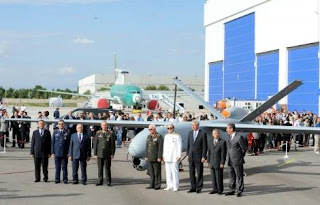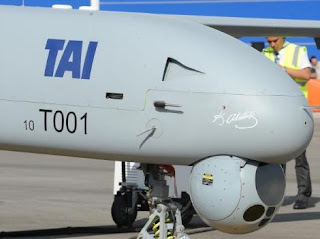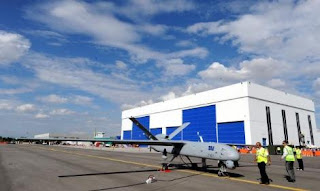http://www.spacedaily.com/reports/Pilotless_drones_show_new_face_of_war_at_Farnborough_999.html
Pilotless drones show new face of war at Farnborough
Pilotless drones, remote-controlled military aircraft destined to play a vital role in combat, took a high-profile place at the Farnborough air show this week.
With unmanned aircraft already being used by NATO forces in Afghanistan for intelligence-gathering but also increasingly in an offensive role, aerospace manufacturers at Farnborough reported brisk sales last year.
Although defence budgets worldwide are being squeezed this year by the fragile economic recovery, companies and analysts said they expected sales of drones to slow less than in other defence aviation sectors.
One machine with a potentially strong commercial future is US defence group Northrop Grumman's Global Hawk, a high-altitude Unmanned Aerial Vehicle (UAV), seen as a potential replacement for the venerable U-2 spy plane.
"The planned date (for U-2 decommissioning) is by 2012, but it is unlikely the U-2 will just drop dead. More likely there will be a draw-down," Northrop Grumman's Director of Business Development Ed Walby told AFP at the Farnborough show near London, a key get-together in the aviation world.
Northrop claimed at the show to have clocked up total sales for all its aircraft of 33.8 billion dollars (26 billion euros) in 2009.
But in a sign of the growing importance of unmanned aircraft, Northrop said it expected the sector to account for 3.5 billion dollars of sales in the next 10 years.
By way of comparison, the total value of orders for aircraft, mainly civil airliners, announced at Farnborough up to Wednesday night was 37.5 billion dollars.
However, with drones playing an increasingly prominent role in warfare, some manufacturers forecast that sales of unmanned aircraft would remain buoyant despite the pressure governments are under to cut defence spending.
US consultancy Forecast International's senior unmanned systems analyst Larry ****erson predicts the market for UAV procurement will be worth almost 18 billion dollars by 2018.
"Western European defence budgets are under a lot of pressure," said Paolo Carmassi, a leading executive at Honeywell Aerospace.
"I wouldn't be surprised to see a reduction in hardware acquisition in the short term and this is something I think the entire industry has to be prepared for."
However a spokesman for US aerospace giant Boeing was far more upbeat.
"UAVs have always been in high demand and we expect the market to continue to grow even with the decrease in spending in the (US) Department of Defense," he told AFP.
Flying at an altitude of 60,000 feet (18,300 metres), UAVs can look down through a sandstorm and destroy unsuspecting targets with clinical precision. All this, while the pilot is nowhere near the aircraft or even the battlefield.
Yet despite the unique combat role played by drones, industry experts stress the need to maintain the man in the cockpit.
"They don't take over. Manned aircraft, at least for the next 40 years, will continue to dominate despite the progressive injection of remotely piloted vehicles in air forces around the world," said Howard Wheeldon, a defence analyst with BGC partners.
Alan S. Colegrove, a senior official at US drone manufacturer AAI added: "Most of the unmanned systems out there are not exactly unmanned, they are remotely controlled."
The emergence of unmanned vehicles that carry out strike missions on enemy targets, as opposed to mere surveillance is taking drone technology to the next level.
The Unmanned Combat Aerial Vehicles (UCAVs) are already being used in conflict zones across Afghanistan.
"I think they are extremely important and here to stay," said Wheeldon.
"They are already with us and playing a crucial role in Afghanistan and they played a role in Iraq. They will save lives and are a cheap form of defence fighting equipment."
US Secretary of State Robert Gates has said that the F-35 Joint Strike Fighter now in production, "may be the last combat aircraft the US Air Force will buy that carries a pilot," signalling a paradigm shift in how the US plans to craft its 21st century battle strategy.
Ahead of Farnborough, a drone manufacturer
claimed that its ultra-light UAV powered by solar energy stayed in the air for a record seven days.
The British-based firm QinetiQ said its 22.5 metre (74-foot) long Zephyr, weighing just 50 kilogrammes (110 pounds), flew over a US military testing ground in Arizona.








